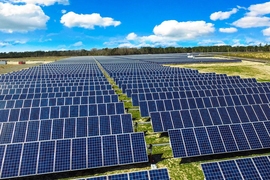MIT researchers have been awarded a grant of nearly $1.3 million through the U.S. Department of Energy’s SunShot Initiative to study the reasons for solar energy’s rapid and sustained cost decline and how to continue reducing costs in the future.
The awarded project, which will examine features of photovoltaic (PV) devices, public policies, and private sector efforts, is titled “Modeling Photovoltaics Innovation and Deployment Dynamics.” It will be led by principal investigator Jessika Trancik, associate professor in MIT's Institute for Data, Systems, and Society (IDSS), along with co-principal investigators Tonio Buonassisi, associate professor in mechanical engineering; and David Hs, assistant professor in urban studies and planning — all of whom are also faculty affiliates of the MIT Energy Initiative — and Robert Margolis of the National Renewable Energy Laboratory. Postdoc James McNerney and PhD student Goksin Kavlak, both of IDSS, are also involved.
To evaluate the mechanisms driving PV system cost reductions, the MIT team will delve deeply into specific past technological innovations and policies, and prospectively assess PV’s potential for future cost reduction. New datasets and modeling frameworks will provide a comprehensive picture of how specific technology and policy developments have led to the dramatic cost reduction in PV in recent decades. This project also provides insights for policymakers, engineers, and other stakeholders to inform their research and development investments and policy designs in the future.
“In this project we will study the reasons for photovoltaics’ cost decline, from materials and device development to manufacturing improvements and public policy design,” says Trancik. “I expect that the most impactful aspects of this work will be the reasons we uncover for photovoltaics’ exceptionally rapid cost decline and how to bring cost down further, as well as the general insights on why technologies improve and how engineering design and policy can support that process.”
“The method we are developing will be a key contribution of the project because it goes beyond correlational analysis and toward a mechanistic model of the reasons for technology improvement, which is what is needed to pin down the reasons,” says Trancik. “This method can be applied to many different technologies in future to help understand the fundamental determinants of technological innovation and how to make it most beneficial to society.”
The project team will build on MIT’s work from the first round of SunShot’s Solar Energy Evolution and Diffusion Studies (SEEDS) program, in which the team created a new analysis method to decompose cost reduction in technologies, using it to answer questions about why crystalline silicon module costs have fallen so quickly. In this second round of SEEDS funding, researchers will further develop this research method and model and apply it to all PV system components across different locations. The project will estimate how much device-level factors, such as larger silicon wafers, improved module efficiency, or better installation methods, and high-level drivers, such as scale economies or research and development, contributed to past reductions. One output of the project will be datasets that capture how PV systems’ costs declined historically and what the key determinants were — from advances in the laboratory to legislative innovations. The lessons learned will be translated into cost reduction strategies going forward.
The MIT project is one of 17 new projects awarded a total of $21.4 million in SunShot funding to help reduce the “soft costs” commonly found with solar energy, such as installation, permitting, and connecting to the grid.
The U.S. Department of Energy SunShot Initiative is a collaborative national effort that aggressively drives innovation to make solar energy fully cost-competitive with traditional energy sources before the end of the decade. Through SunShot, the Department of Energy supports efforts by private companies, universities, and national laboratories to reduce the cost of solar electricity to $0.06 per kilowatt-hour.










